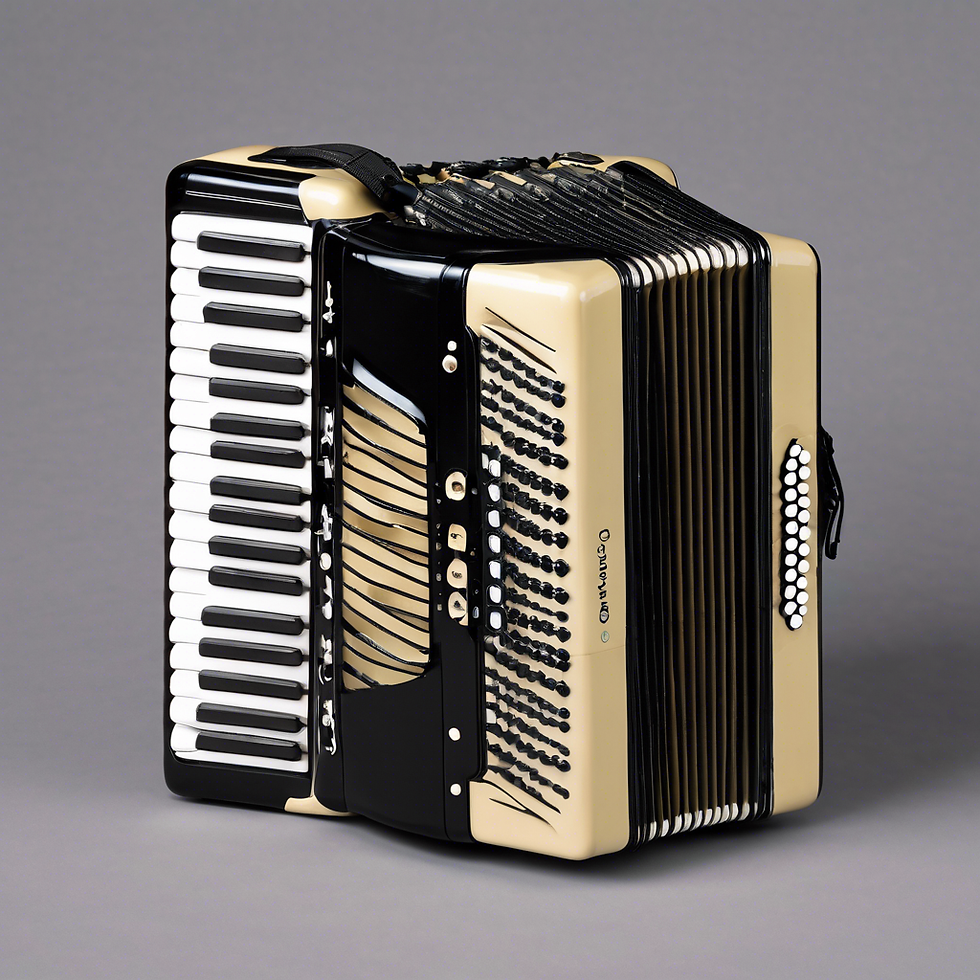
The Accordion: A Journey Through History and Music
- Mirco Lieber, MMag.

- Aug 17
- 4 min read
The accordion, often viewed as a staple of folk music, has a rich and varied history that spans centuries and continents. This fascinating instrument, with its distinctive sound and compact design, has evolved remarkably, shaping and being shaped by the cultures it encounters along the way. In this blog post, we will delve deeper into the origins of the accordion, explore its evolution, and examine its cultural significance in various regions around the world.
Origins of the Accordion
The accordion's story begins in the early 19th century. In 1822, the first known patent for an accordion was granted in Berlin to Cyril Demian, an Armenian instrument maker. Demian's invention featured a bellows, keyboard, and a set of reed pipes that produced sound when air was pushed through them. This early design utilized a simple keyboard that played melody notes while the air valves allowed for chords.
Over the years, the instrument gained popularity across Europe and various modifications emerged. The “piano accordion” was developed in the 1850s, adding a piano-style keyboard to one side, which expanded its appeal. It quickly became a beloved instrument in folk music traditions, as well as in the realms of classical and popular music.

Evolution Over Time
As the accordion spread across the globe, it adapted to different musical styles and genres. In France, the accordion became intertwined with the café culture of the late 19th century. Parisian musicians quickly adopted it, cementing its place in the French chanson style.
In the United States, immigrants brought the accordion with them, where it became synonymous with the traditional sounds of polka music, particularly among Polish and German communities. By the 20th century, the accordion paved its way into popular music, featuring in the recordings of artists like Frank Yankovic and Myron Floren.

Cultural Significance in Various Regions
The accordion's cultural footprint is as diverse as the regions it has traveled. In Latin America, for instance, the accordion has become a crucial element of genres such as Norteño and Tejano music. In Mexico, it serves as a vital instrument that enriches traditional folk music. The instruments and their sound often invoke feelings of nostalgia among the communities that cherish them.
Similarly, in Eastern Europe, the accordion is central to the folk traditions of countries like Hungary, Romania, and the Balkans. Each of these cultures has unique styles associated with the accordion, showcasing the instrument's adaptability. In some settings, it accompanies traditional dances, while in others, it provides the backdrop for storytelling through song.

The Accordion Across Music Genres
The versatility of the accordion has allowed it to find a place in a wide array of music genres. In addition to folk and traditional music, the accordion has crossed over into genres such as jazz, rock, and classical music.
Notably, in jazz music, accordionists like Art Van Damme and Richard Galliano have pushed the instrument's boundaries beyond its folkloric origins. The ability to create varied tonal textures allows accordionists to explore improvisation in ways similar to other jazz instruments.
In rock music, the accordion has made its mark with artists like The Pogues and Bruce Springsteen. Its unique timbre can provide a distinctive sound that complements traditional rock instrumentation.
Additionally, contemporary genres such as pop and electronic music have also welcomed the accordion. Artists like Lady Gaga and Arcade Fire have integrated it into their sound, showcasing its modern relevance.
Impact on Modern Music
Today, the accordion is enjoying a renaissance in modern music. With the rise of technology, new accordion designs and electronic models like the digital accordion have emerged, allowing musicians to explore new possibilities. These advancements have also made it easier for musicians and audiences alike to reconnect with the instrument.
Digital platforms and social media have enabled accordionists to share their work globally, fostering collaborative efforts and community-building among musicians. This increased visibility also highlights the instrument's unique sound and cultural significance, attracting a new generation of accordion enthusiasts.
Organizations and festivals dedicated entirely to the accordion have sprung up, reinforcing its role in contemporary music. Events like the International Accordion Festival foster talent and encourage cultural exchange, helping to keep the tradition alive while also evolving with modern influences.
In a world that often celebrates the new and innovative, the accordion stands as a reminder of the rich tapestry of musical history. Its journey from folk instrument to a modern music staple reflects a profound connection to our human experiences and traditions.
The importance of the accordion extends beyond just music; it is an embodiment of cultural identity and community. As more musicians discover its versatility, the accordion's place in the fabric of modern music continues to thrive, contributing to the diversity of sound that defines our current musical landscape.
Celebrating the Accordion's Legacy
As we reflect on the accordion's history, it’s clear that this instrument is more than just a musical tool; it's a bridge between cultures, eras, and genres. Its evolution is a testament to the creativity and adaptability of musicians and their desire to connect through sound.
Understanding the cultural impact of the accordion can lead to greater appreciation for various musical traditions. Whether you find yourself tapping your feet to a lively polka, swaying to a romantic French ballad, or losing yourself in an avant-garde jazz piece, the accordion remains a powerful instrument that has shaped music world over.
As music continues to evolve, so does the accordion's role within it. Whether you are a seasoned performer or a casual listener, embracing the accordion's rich history allows you to appreciate not just the sound it produces, but the stories it tells and the connections it fosters.
In an age where the digital often overshadows the analog, the accordion thrives as a vibrant symbol of our collective musical heritage. So, the next time you hear an accordion, take a moment to appreciate its journey and the myriad of cultures that meld into its melodious notes.

































Comments